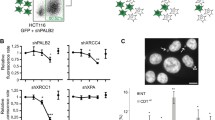Abstract
U 46 D Fluid (the dimethylammonium salt of 2,4-dichlorophenoxyacetic acid in a commercial formulation) was more toxic to human fibroblasts than 2,4-dichlorophenoxyacetic acid (2,4-D). Moreover, U 46 D Fluid induced single-strand breaks at apurinic/apyrimidinic (AP) sites of heat-acid treated PM2 DNA while 2,4-D did not. The1H-NMR spectrum of the dimethylammonium (DMA) salt of 2,4-D indicated the formation of a complex via a six-membered aggregate of the DMA ion and the acid group of 2,4-D. The role of complex formation of the DMA salt of 2,4-D as a cause of single-strand breaking activity and increased cytotoxicity is discussed.
Similar content being viewed by others
References
Ahmed FE, Hart RW, Lewis NJ (1977a) Pesticide induced DNA damage and its repair in cultured human cells.Mutat Res 42: 161–174
Ahmed FE, Lewis NJ, Hart RW (1977b) Pesticide induced ouabain resistant mutants in Chinese hamster V79 cells.Chem Biol Interact 19 [3]: 369–374
Andersen KJ, Leighty EG, Takahashi MT (1972) Evaluation of herbicides for possible mutagenic properties.J Agr Food Chem 20 (3): 649–656
Hadi SM, Goldthwait DA (1971) Endonuclease II ofEscherichia coli Degradation of partially depurinated desoxyribonucleic acid.Biochemistry 10: 4986–4994
Hecht R, Thielmann HW (1978) Purification and characterization of an endonuclease fromMicrococcus luteus that acts on depurinated and carcinogen-modified DNA.Eur J Biochem 89: 607–618
International Agency for Research on Cancer (1982) IARC monographs on the evaluation of the carcinogenic risk of chemicals to humans. Vol. 1–29, Suppl. 4, Lyon, pp 101–103
Kappas A (1988) On the mutagenic and recombinogenic activity of certain herbicides inSalmonella typhimurium and inAspergillus nidulans.Mutat Res 204: 615–621
Khalatkar AS, Bhargava YR (1982) 2,4-Dichlorophenoxyacetic acid — a new environmental mutagen.Mutat Res 103: 111–114
Korte C, Jalal SM (1982) 2,4-D induced clastogenicity and elevated rates of sister chromatid exchanges in cultured human lymphocytes.J Hered 73: 224–226
Laval J., Pierre J (1981) Specific nicking of DNA at apurinic sites by peptides containing aromatic residues.J Biol Chem 256: 10217–10220
Lindahl T, Nyberg B (1972) Rate of depurination of native desoxyribonucleic acid.Biochemistry 11 [19]: 3610–3618
Livingstone DC (1964) Degradation of apurinic acid by condensation with aldehyde reagents.Biochim Biophys Acta 87: 538–540
Loeb LA (1985) Apurinic sites as mutagenic intermediates.Cell 40: 483–484
Magnusson J, Ramel C, Eriksson A (1977) Mutagenic effects of chlorinated phenoxyacetic acid inDrosophila melanogaster.Hereditas 87: 121–123
Malvy C, Prévost P, Gansser C, Viel C, Paoletti C (1986) Efficient breakage of DNA apurinic sites by the indole, amine related 9-amino-ellipticine.Chem Biol Interact 57: 41–53
Mustonen R, Kangas J, Vuojolahti P, Linnainmaa K (1986) Effects of phenoxyacetic acids on the induction of chromosome aberrations in vitro and in vivo.Mutagenesis 1 [4]: 241–245
Nesnow S, Argus M, Bergman H, Chu K, Frith C, Helmes T, McGaughy R, Ray V, Slaga TJ, Tennant R, Weisburger E (1986) Chemical carcinogens. A review and analysis of the literature of selected chemicals and the establishment of the Gene-Tox Carcinogen Data Base.Mutat Res 185: 1–195
Pilinskaya MA (1974) Cytogenetic effect of the herbicide 2,4-D on human and animal chromosomes.Tsitol Genet 8 [3]: 202–206
Siebert D, Lemperle E (1974) Genetic effects of herbicides. Induction of mitotic gene conversion inSaccharomycescerevisiae.Mutat Res 22: 111–120
Thielmann HW, Witte I (1980) Correlation of the colony-forming abilities of Xeroderma pigmentosum fibroblasts with repair-specific DNA incision reactions catalyzed by cell-free extracts.Arch Toxicol 44: 197–207
Vogel E, Chandler JLR (1974) Mutagenicity testing of cyclamate and some pesticides inDrosophila melanogaster.Experientia 30 [6]: 621–623
Zetterberg G, Busk L, Elovson R, Starec-Nordenhammar I, Ryttman H (1977) The influence of pH on the effects of 2,4-D (2,4-dichlorophenoxyacetic acid, Na salt) onSaccharomyces cerevisiae andSalmonella typhimurium.Mutat Res 42: 3–18
Author information
Authors and Affiliations
Rights and permissions
About this article
Cite this article
Clausen, M., Leier, G. & Witte, I. Comparison of the cytotoxicity and DNA-damaging properties of 2,4-D and U 46 D Fluid (dimethylammonium salt of 2,4-D). Arch Toxicol 64, 497–501 (1990). https://doi.org/10.1007/BF01977633
Received:
Revised:
Accepted:
Issue Date:
DOI: https://doi.org/10.1007/BF01977633




